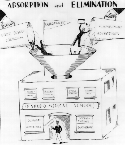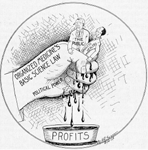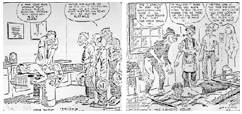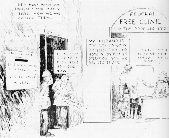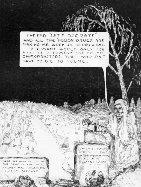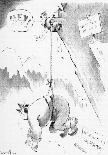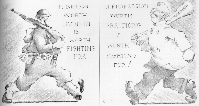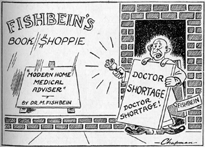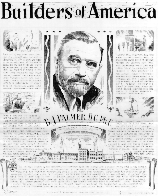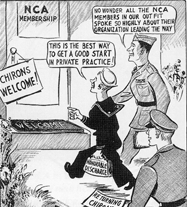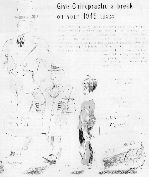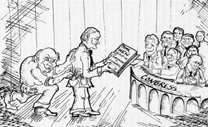Sprinkled throughout the chiropractic literature is a rich tradition of cartooning (Association, 1996) which, like its wider counterparts, tells many fascinating stories.
An advertisement from the Palmer School for the Neurocalometer(NCM).
This view of B.J. Palmer and the unknown validity of the NCM appeared in the July, 1932 issue of The Montana Chirolite, edited and published by C.O. Watkins, DC.
This image is from Price List of Printery Products and Office Supplies. Davenport IA: Palmer School of Chiropractic, August 10, 1925. It offers B.J. Palmer's explanation of the mechanism of subluxations, "foot on the hose."
This cartoon suggests straight chiropractors' view of mixer chiropractic education in California; from the California Chiropractic Association Bulletin 1931 (Nov); 1(2):6.
This cartoon suggests straight chiropractors' view of mixer chiropractic education in California; from the California Chiropractic Association Bulletin 1931 (Nov); 1(2):6.
Chiropractors' view of basic science laws, from The Chiropractic Journal (NCA), April, 1936 (left). By the mid-1930s, the passage of basic science laws in many states seriously threatened to decimate the ranks of the chiropractic profession. the image at right appeared in The Chiropractic Journal (NCA)in October, 1938.
These sketches of "bloodless surgeon" Francis J. Kolar, DC, first appeared in the Evening Beacon of Wichita, Kansas on 18 September, 1936, and were reprinted as an advertisement in the November, 1936 issue of the NCA's The Chiropractic Journal (p. 35).
These two cartoons, featuring "The Bunkhouse Gang" and drawn by Canadian-born artist J.R. Williams, appeared in more than a thousand newspapers throughout North America in 1937 (Miscellany, 1982).
Cover illustration from What Chiropractic is Doing, a hardbound book of testimonials published by the Burton Shields Company of Indianapolis, 1938.
This cartoon expressed chiropractors' attitude toward allopathy's resistance to federal health care programs, from The Chiropractic Journal (NCA), November, 1938.
For as long as allopaths have been branding chiropractors "rabid dogs and killers" (Wardwell, 1992, p. 162), DCs have hurled similar accusations at the dominant sect. Here, broad-scope chiropractors expressed their view of the competition in the December, 1938 issue of The Chiropractic Journal (NCA).
The broad-scope National Chiropractic Association sought to expand its ranks with this message in the November, 1941 issue of the National Chiropractic Journal.
War-time themes were woven into appeals for professional membership and unity, from the December, 1941 issue of the National Chiropractic Journal.
This 1942 image invited chiropractors to join a wartime society of all DCs; from the National Chiropractic Journal, 1942.
In November, 1942, U.S. Senator Claude Pepper (Democrat, Florida) criticized an ad for Morris Fishbein, MD's new book, Modern Home Medical Adviser. Pepper charged that Fishbein, editor of the Journal of the American Medical Association, was "capitalizing on the shortage of doctors" to promote the sale of his latest volume. "The ad stated that the book could be used to advantage 'when a scream of pain terrifies your home' and no doctor is available. It added that there are now '25,000 doctors in uniform and more being taken every day.' 'I hope,' Pepper said, 'that we can protect the medical profession against such charlatanism.'" (From the National Chiropractic Journal for December, 1942, p. 23.)
The traditional chiropractic angel (left), designed in 1929 by artist M. McDonald was first promoted by the Burton Shields Company and subsequently by the National Chiropractic Association (Nash & Keating, 1993). The angel underwent a dramatic metamorphosis during World War II (image on right from the August, 1943 issue of the National Chiropractic Journal, p. 4).
The International Chiropractors' Association offered these images in September, 1947 to describe its president, Dr. B.J. Palmer.
The National Chiropractic Association welcomed returning chiropractor-veterans ("chirons") back from World War II in this sketch, from the National Chiropractic Journal for January, 1946.
This advertisement for the Chiropractic Research Foundation (precursor of today's Foundation for Chiropractic Education & Research), depicting Uncle Sam strolling with organized medicine while a poor-boy chiropractic watches. It appeared in the December, 1949 issue of the Journal of the National Chiropractic Association (p. 23).
These characterizations of several beloved faculty members of the Los Angeles College of Chiropractic (left to right: anatomist Arthur Nilsson, BS, DC; director of research Henry Higley, DC, MS; administrative dean Raymond Houser, DC, ND and professor J. Gordon Anderson, BSc, DC, ND) appeared in the early 1950s in the college's journal, the Chirogram, and in the college yearbooks.
Top: Thurman Fleet, DC's concept-therapy offered a "stickman" diagram of the structure of personality. This was expanded into a dyad (center) to suggest how the chiropractor influences the patient. At bottom is a further elaboration developed by one of Fleet's early students, James W. Parker, DC (Keating & Fleet, 1997).
This "low cost envelope stuffer" was offered by the NCA in the April, 1951 issue of its journal.
A student stressed out by his preparations for final exams and basic science examinations asks, "All this for a license to replace a malpositioned vertebra?"; from the 1956-57 yearbook of the Cleveland Chiropractic College of Kansas City.
This sketch (Trever, 1972) suggests AMA attorney H. Doyl Taylor's role in influencing the 1968 report on chiropractic issued by HEW Secretary Wilburn Cohen in preparation for considering chiropractic inclusion in Medicare.
References:
Association notes: chiropractic cartoons. Chiropractic History 1996 (Dec); 16(2):12.
Ernst R. Weakness is a Crime: the Life of Bernarr Macfadden. Syracuse University Press, 1991.
Keating JC. James F. McGinnis, DC, ND, CP: spinographer, educator, marketer and bloodless surgeon. Chiropractic History 1998 (Dec); 18(2): 63-79.
Keating JC, Fleet GT. Thurman Fleet, DC and the early years of the Concept-Therapy Institute. Chiropractic History 1997 (June); 17(1): 57-65.
Keating JC, Rehm WS. William C. Schulze, MD, DC (1870-1936): from mail-order mechano-therapists to scholarship and professionalism among drugless physicians, part I. Chiropractic Journal of Australia 1995 (Sept); 25(3): 82-92.
Keating JC, Rehm WS. William C. Schulze, MD, DC (1870-1936): from mail-order mechano-therapists to scholarship and professionalism among drugless physicians, part II. Chiropractic Journal of Australia 1995 (Dec); 25(4): 122-8.
Nash J, Keating JC. The birth of the chiropractic angel. Chiropractic History 1993 (Dec); 13(2):26-9.
Miscellany II: Getting it both ways from the "crunch" image. Chiropractic History 1982; 2:45.
Palmer BJ, Palmer DD. The Science of Chiropractic. Davenport IA: Palmer School of Chiropractic, 1906, Illustration no. 27.
Trever W. In the Public Interest. Los Angeles: Scriptures Unlimited, 1972.
Wardwell WI. Chiropractic: History and Evolution of a New Profession. St. Louis: Mosby, 1992.
If your interest in chirohistory has been stimulated, then consider joining the Association for the History of Chiropractic (AHC). Founded at Spears Hospital in Denver in 1980, the AHC is a non-profit, membership organization whose goal is the discovery, dissemination and preservation of the saga of chiropractic. The AHC held its first annual Conference on Chiropractic History at the Smithsonian Institute in Washington, D.C. in 1980, and has held similar conferences each years since at various chiropractic colleges. The AHC's 2000 Conference on Chiropractic History will be held in San Antonio, Texas in conjunction with the annual meeting of the Association of Chiropractic Colleges, during March, 2000. Details about the upcoming conference can be obtained by contacting any CCE-accredited college.
The AHC publishes a scholarly journal, Chiropractic History, in which chiropractors and interested observers contribute their expertise to telling and interpreting the rich lore of the profession. The journal, which is indexed in the National Library of Medicine's Bibliography of the History of Medicine, is published twice per year. Chiropractic History is distributed to all members of the AHC as a membership benefit. Membership in the AHC can be obtained by sending your name, address and check for $50 ($20/year for students) to the AHC's executive director:
Glenda Wiese, M.A.,
Executive Director
Association for the
History of Chiropractic
1000 Brady Street, Davenport IA 52803 USA
If you'd like to encourage historical scholarship and preservation within the chiropractic profession, then consider making a donation, large or small, to the historical fund of the National Institute of Chiropractic Research (NICR). The NICR is a non-profit organization committed to conducting and supporting various types of research; in most cases, contributions are tax-deductible. The NICR historical fund supports the work of chiropractic historians and of centers for the preservation of historical documents. Preparation of this paper was supported by the NICR. Please make your check payable to: Historical Fund
National Institute
of Chiropractic Research
P.O. Box 80317,
Phoenix AZ 85060-0317 USA
Thank you.
Click here for previous articles by Joseph Keating Jr., PhD.









